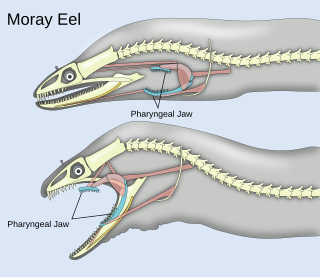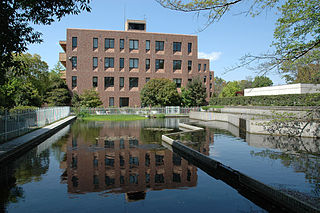Related Research Articles

Cichlids are fish from the family Cichlidae in the order Cichliformes. Traditionally Cichlids were classed in a suborder, the Labroidei, along with the wrasses (Labridae), in the order Perciformes, but molecular studies have contradicted this grouping. On the basis of fossil evidence, it first appeared in Tanzania during the Eocene epoch, about 46–45 million years ago. The closest living relative of cichlids is probably the convict blenny, and both families are classified in the 5th edition of Fishes of the World as the two families in the Cichliformes, part of the subseries Ovalentaria. This family is large, diverse, and widely dispersed. At least 1,650 species have been scientifically described, making it one of the largest vertebrate families. New species are discovered annually, and many species remain undescribed. The actual number of species is therefore unknown, with estimates varying between 2,000 and 3,000.
Gene duplication is a major mechanism through which new genetic material is generated during molecular evolution. It can be defined as any duplication of a region of DNA that contains a gene. Gene duplications can arise as products of several types of errors in DNA replication and repair machinery as well as through fortuitous capture by selfish genetic elements. Common sources of gene duplications include ectopic recombination, retrotransposition event, aneuploidy, polyploidy, and replication slippage.

In evolutionary biology, sympatric speciation is the evolution of a new species from a surviving ancestral species while both continue to inhabit the same geographic region. In evolutionary biology and biogeography, sympatric and sympatry are terms referring to organisms whose ranges overlap so that they occur together at least in some places. If these organisms are closely related, such a distribution may be the result of sympatric speciation. Etymologically, sympatry is derived from Greek συν (sun-) 'together', and πατρίς (patrís) 'fatherland'. The term was coined by Edward Bagnall Poulton in 1904, who explains the derivation.

Eugene Viktorovich Koonin is a Russian-American biologist and Senior Investigator at the National Center for Biotechnology Information (NCBI). He is a recognised expert in the field of evolutionary and computational biology.
Gabriel A. Dover was a British geneticist, best known for coining the term molecular drive in 1982 to describe a putative third evolutionary force operating distinctly from natural selection and genetic drift.

Masatoshi Nei was a Japanese-born American evolutionary biologist.
Wen-Hsiung Li is a Taiwanese-American scientist working in the fields of molecular evolution, population genetics, and genomics. He is currently the James Watson Professor of Ecology and Evolution at the University of Chicago and a Principal Investigator at the Institute of Information Science and Genomics Research Center, Academia Sinica, Taiwan.

Takashi Gojobori is a Japanese molecular biologist, Vice-Director of the National Institute of Genetics (NIG) and the DNA Data Bank of Japan (DDBJ) at NIG, in Mishima, Japan. Gojobori is a Distinguished Professor at King Abdullah University of Science and Technology (KAUST) in Thuwal, Saudi Arabia. He is a Professor of Bioscience and Acting Director at the Computational Bioscience Research Center at KAUST.

Pharyngeal jaws are a "second set" of jaws contained within an animal's throat, or pharynx, distinct from the primary or oral jaws. They are believed to have originated as modified gill arches, in much the same way as oral jaws. Originally hypothesized to have evolved only once, current morphological and genetic analyses suggest at least two separate points of origin. Based on connections between musculoskeletal morphology and dentition, diet has been proposed as a main driver of the evolution of the pharyngeal jaw. A study conducted on cichlids showed that the pharyngeal jaws can undergo morphological changes in less than two years in response to their diet. Fish that ate hard-shelled prey had a robust jaw with molar-like teeth fit for crushing their durable prey. Fish that ate softer prey, on the other hand, exhibited a more slender jaw with thin, curved teeth used for tearing apart fleshy prey. These rapid changes are an example of phenotypic plasticity, wherein environmental factors affect genetic expression responsible for pharyngeal jaw development. Studies of the genetic pathways suggest that receptors in the jaw bone respond to the mechanical strain of biting hard-shelled prey, which prompts the formation of a more robust set of pharyngeal jaws.

Joachim Wilhelm "Jo" Messing was a German-American biologist who was a professor of molecular biology and the fourth director of the Waksman Institute of Microbiology at Rutgers University.
William Martin is an American botanist and microbiologist, currently Head of the Institut für Molekulare Evolution, Heinrich Heine Universität, Düsseldorf.

The National Institute for Basic Biology (NIBB) is a research institute and post graduate university in Okazaki City, Aichi Prefecture, Japan. It was founded in 1977 to promote biological research in Japan in cooperation with public and private universities, and research institutes.

Detlef Weigel is a German American scientist working at the interface of developmental and evolutionary biology.
James A. Lake is an American evolutionary biologist and a Distinguished Professor of Molecular, Cell, and Developmental Biology and of Human Genetics at UCLA. Lake is best known for the New Animal Phylogeny and for the first three-dimensional structure of the ribosome. He has also made significant contributions to understanding genome evolution across all kingdoms of life, including discovering informational and operational genes, elucidating the complexity hypothesis for gene transfer, rooting the tree of life, and understanding the early transition from prokaryotic to eukaryotic life.
Wilhelm Boland is a German chemist.

Diethard Tautz is a German biologist and geneticist, who is primarily concerned with the molecular basis of the evolution of mammals. Since 2006 he is director at the Max Planck Institute for Evolutionary Biology in Plön.

Peter D. Keightley FRS is Professor of Evolutionary Genetics at the Institute of Evolutionary Biology in School of Biological Sciences at the University of Edinburgh.

Sarah Amalia Teichmann is a German scientist who is head of cellular genetics at the Wellcome Sanger Institute and a visiting research group leader at the European Bioinformatics Institute (EMBL-EBI). She serves as director of research in the Cavendish Laboratory, at the University of Cambridge and a senior research fellow at Churchill College, Cambridge.

David P. Mindell is an American evolutionary biologist and author. He is currently a senior researcher at the University of California, Berkeley, Museum of Vertebrate Zoology. Mindell's work is focused on the systematics, conservation and molecular evolution of birds, especially birds of prey. He is known for his 2006 book, The Evolving World in which he explained, for the general public, how evolution applies to everyday life.
Erich Bornberg-Bauer is an Austrian biochemist, theoretical biologist and bioinformatician.
References
- ↑ Wilson, Allan C.; Basasibwaki, Pereti; Kocher, Thomas D.; Meyer, Axel (October 1990). "Monophyletic origin of Lake Victoria cichlid fishes suggested by mitochondrial DNA sequences". Nature. 347 (6293): 550–553. Bibcode:1990Natur.347..550M. doi:10.1038/347550a0. PMID 2215680. S2CID 4357674.
- ↑ Meyer, Axel; Snoeks, Jos; Salzburger, Walter; Verheyen, Erik (11 April 2003). "Origin of the Superflock of Cichlid Fishes from Lake Victoria, East Africa". Science. 300 (5617): 325–329. Bibcode:2003Sci...300..325V. CiteSeerX 10.1.1.584.2497 . doi:10.1126/science.1080699. PMID 12649486. S2CID 84478005.
- ↑ Meyer, A.; Schartl, M. (1999). "Gene and genome duplications in vertebrates: The one-to-four (-to-eight in fish) rule and the evolution of novel gene functions". Current Opinion in Cell Biology. 11 (6): 699–704. doi:10.1016/S0955-0674(99)00039-3. PMID 10600714.
- ↑ Peer, Yves Van de; Meyer, Axel; Frickey, Tancred; Braasch, Ingo; Taylor, John S. (March 2003). "Genome Duplication, a Trait Shared by 22,000 Species of Ray-Finned Fish". Genome Research. 13 (3): 382–390. doi:10.1101/gr.640303. PMC 430266 . PMID 12618368.
- ↑ Wilson, Allan C.; Meyer, Axel (November 1990). "Origin of tetrapods inferred from their mitochondrial DNA affiliation to lungfish". Journal of Molecular Evolution. 31 (5): 359–364. Bibcode:1990JMolE..31..359M. doi:10.1007/BF02106050. PMID 2124628. S2CID 10516227.
- ↑ Zardoya, Rafael; Meyer, Axel (24 November 1998). "Complete mitochondrial genome suggests diapsid affinities of turtles". Proceedings of the National Academy of Sciences. 95 (24): 14226–14231. Bibcode:1998PNAS...9514226Z. doi: 10.1073/pnas.95.24.14226 . PMC 24355 . PMID 9826682.
- ↑ Schartl, Manfred; Morrissey, Jean M.; Meyer, Axel (April 1994). "Recurrent origin of a sexually selected trait in Xiphophorus fishes inferred from a molecular phylogeny" (PDF). Nature. 368 (6471): 539–542. Bibcode:1994Natur.368..539M. doi:10.1038/368539a0. PMID 8139686. S2CID 4329410.
- ↑ Meyer, Axel; Muschick, Moritz; Salzburger, Walter; Stölting, Kai N.; Barluenga, Marta (February 2006). "Sympatric speciation in Nicaraguan crater lake cichlid fish". Nature. 439 (7077): 719–723. Bibcode:2006Natur.439..719B. doi:10.1038/nature04325. PMID 16467837. S2CID 3165729.
- 1 2 "Prof. Dr. Axel Meyer". Evolutionsbiologie Uni Konstanz.
- ↑ "Popular Press". Evolutionsbiologie Uni Konstanz.
- ↑ "Quantensprung Column". Evolutionsbiologie Uni Konstanz.
- ↑ "EMBO press release".
- ↑ "Academy of Europe: Meyer Axel". ae-info.org. Retrieved 5 March 2021.
- ↑ German National Academy of Sciences Leopoldina. Newly elected members 2009 Archived 23 July 2011 at the Wayback Machine .
- ↑ "Members – EUROPEAN ACADEMY OF SCIENCES AND ARTS (EASA)". www.euro-acad.eu.
- ↑ Katja. "Members". Archived from the original on 16 January 2013. Retrieved 17 February 2011.
- ↑ jofi. "Aktuelle Mitglieder — Berlin-Brandenburgische Akademie der Wissenschaften". www.bbaw.de. Archived from the original on 2 March 2015. Retrieved 17 February 2011.
- ↑ Germany Academy of Sciences Leopoldina, list of Carus Medal recipients Archived 23 July 2011 at the Wayback Machine
- ↑ List of Guggenheim Fellowships awarded in 1996
- ↑ John Simon Guggenheim Memorial Foundation, recipient Axel Meyer Archived 28 June 2011 at the Wayback Machine
- ↑ American Society of Naturalists, Young Investigator Prize, list of recipients Archived 17 July 2011 at the Wayback Machine
- ↑ "Startseite: Hector Fellow Academy". Archived from the original on 14 February 2015. Retrieved 14 January 2015.
- ↑ "Axel Meyer". Radcliffe Institute for Advanced Study at Harvard University. Retrieved 5 March 2021.
- ↑ Winkler, L. 2010. Laborjournal. List of most highly cited German Evolutionary Biologist 2004–2007 Archived 14 February 2015 at the Wayback Machine .
- ↑ Publication Analysis 1996–2006: Evolutionary Biology Archived 14 February 2015 at the Wayback Machine . Labtimes Online Archived 14 February 2015 at the Wayback Machine .
- ↑ "Press coverage". Evolutionsbiologie Uni Konstanz.
- ↑ Abbott, Alison (1 July 2004). "Junior biologists score partial victory over lab conditions". Nature. 430 (6995): 7. Bibcode:2004Natur.430....7A. doi: 10.1038/430007a . ISSN 0028-0836. PMID 15229572.
- 1 2 3 Willmann, Urs (8 July 2004). "Hauen und Stechen am Bodensee". Zeit.de (in German). Retrieved 6 January 2020.
- 1 2 Science, American Association for the Advancement of (2 July 2004). "ScienceScope". Science. 305 (5680): 27. doi:10.1126/science.305.5680.27a. ISSN 0036-8075. PMID 15232079. S2CID 84093340.
- ↑ Málaga-Trillo, E.; Gerlach, G. (September 2004). "Meyer case poses a challenge to the system". Nature. 431 (7008): 505. Bibcode:2004Natur.431..505M. doi: 10.1038/431505b . ISSN 0028-0836. PMID 15457230.
- 1 2 3 Vences, M.; Zardoya, R. (September 2004). "Meyer: disagreements but no misconduct". Nature. 431 (7008): 505. Bibcode:2004Natur.431..505V. doi: 10.1038/431505c . ISSN 1476-4687. PMID 15457231.
- 1 2 3 4 Meyer, Axel. "Arbeitsmoral an Hochschulen: Ehre und Ehrlichkeit der Studenten". FAZ.NET (in German). ISSN 0174-4909 . Retrieved 31 July 2018.
- ↑ Dickler, Jessica (18 July 2017). "Loans get even more expensive, tightening the chokehold on students". CNBC. Retrieved 31 July 2018.
- 1 2 Maisch, Andreas (19 May 2015). "Uni Konstanz: Axel Meyer entschuldigt sich für Kritik". DIE WELT. Retrieved 31 July 2018.
- ↑ "Stellungnahme | Universität Konstanz". 12 November 2016. Archived from the original on 12 November 2016. Retrieved 31 July 2018.
- ↑ Axel Meyer publications indexed by Google Scholar
- ↑ "Publons" . Retrieved 19 June 2019.